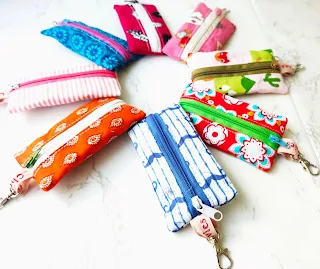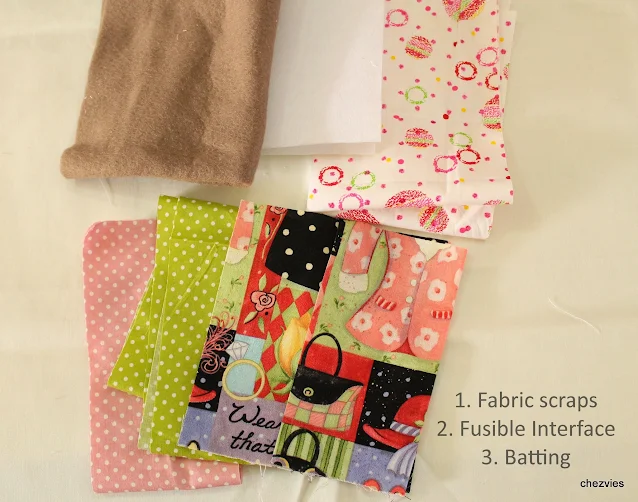In this tutorial, I use a simple zipper with a tab. There are several methods on how you install zippers in pouched and bags. I will try to post a few mini-tutorial on those methods.
FAQ :
1. What interfacing do you use?
Interfacing depends on how you want the look that you want. It totally depends on you. I love soft pouches. I normally use fusible interfacing and flannel or fleece batting (that's a substitute for fusible fleece). For a stiffer pouch, I use canvas interfacing.
2. Batting
As I mentioned, I usually use flannel for quilted pouches or bags. Flannel gives a good structure and enough softness. I use fleece or cotton batting for gadget cases.
3. How to reduce the bulk?
Always cut your batting 1/2" smaller than the main and lining fabric. If you use thicker interfacing, cut the interfacing 1/2" less than the main and lining fabric. That will save you lots of headaches struggling with the machine.
4. Ironing
Ironing is also very important. Iron your interfacing well. I normally set in Cotton and always use the DRY setting. Iron your fabric first then attach the interfacing. If you use anything other than cottons, like silk or cotton mix, do not iron on the fabric. Iron nicely on the interfacing, reduce the heat to (silk/rayon) then iron gently.
That's as far as I can remember. Ask away if you have more questions.
*** Please refer to the numbering of each photo ***
Let's start
Supplies :
Fabric scraps
Fusible Interfacing
Batting (fleece, cotton, or flannel)
Zipper {sorry forgot to include it in the photos)
Embellishment (ribbon, lace, buttons)
Cut the fabrics according to the pics and sew up the strips accordingly
iron flat and sew the green polka dots
Green polka dots: 3" x 9"
**ironing is very important to get a crisp look **
Please NOTE that you NEED to frequently straighten your panel
Use DRY setting and COTTON setting to fuse the fusible interfacing
First, iron the fabric and then attach the interfacing.
This is important, cos it's difficult to smoothen wrinkled-interfaced-fabric.
here I cut the tab 1" x 2"
Trim the metal stopper of the zipper and cut 8" (1" smaller than the panel)
Sew the tab to both zipper ends
now, decorate your pouch panel
this is the fun part
I did a little quilting with this decorative stitch in my HV
I love my Viking, it has all fancy decorative stitches
Now ZIPPER time!
Don't be scared
it's very easy!
Follow the steps in pic #9 below
remember, ALWAYS use zipper foot!
you can either baste it first or you can pin and sew
1st zipper is done, now the second part
Open the panels as shown in pic #10
(remember, the position of the zipper should be like pic #9)
Bring the zipper to the main panel. Line up the sides properly
you can pin the middle panel if you want
Now, fold the lining and line it up on top of the zipper
it should look like pic #13
now pin and sew the zipper
once the zipper is installed
pull out and separate the main and lining as shown in pic #13-1
we're almost done! yay
before pinning your panels, make sure that the laces are matched. You don't want as lopsided pouch, right?
and trim the batting 1/4" all around.
This is to reduce the bulk
match the zipper point
the seam facing the lining and pin
Don't forget to OPEN the zipper halfway!
Now all sides pinned
trim the zipper tab and start sewing
sew with 1/4" or 3/8" on one side
don't forget to back-stitch on both ends
On the other side, leave a 2" opening on the LINING side.
This will be your turning point
Back-stitch on both ends and also at the opening points.
This is important, cos you don't want your stitch to unravel while you're turning the pouch
now, let's make the square bottom
Method #1: puff up the corner and pinch evenly and mark 1/2" from the corner
sew the marked line and cut the excess
or you can do
Method #2
Cut 1/2" square at all corners
and sew them close.
This is easier cos you tend to get a more even box bottom
So that's done, now turn inside out from the opening
do it gently! I know it's frustrating but it is DOABLE.
Once done, check the corners, if you're happy with the result, iron your pouch (main and lining)and sew the opening, either by hand or machine.
Yay! you got new pretty patchwork pouch you can flaunt to your friends.
and if the sewing machine is not your best friend, you can always visit my SHOP and I'll be glad to make one ESPECIALLY for you ^^
I hope you enjoy my tutorial
Happy Weekends & Happy Sewing
Elvira
****










































